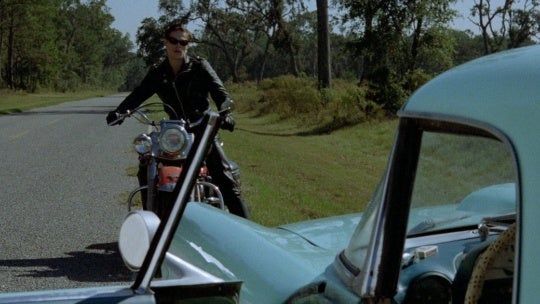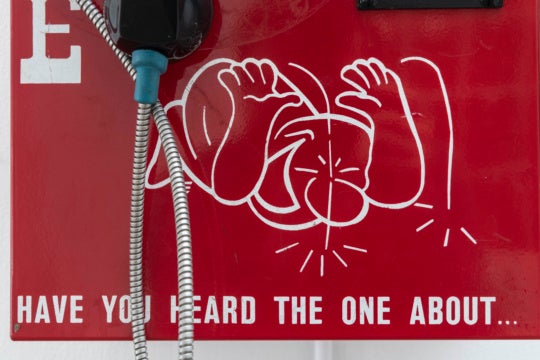
If there is one thing millennial culture is not short of it seems to be irony, so it is all too easy to write off any historical references as exercises in tongue-in-cheek insincerity. Such an approach would be a mistake with Brendan Carroll’s exhibition Decals, on view through October 17 at {Poem 88}. Grounded first in a reference to a long-forgotten symbol of family safety – literally a sticker that read “Tot Finder,” which families would place in their home windows to indicate to firefighters that children were inside – the exhibition is in fact something far more subtle, yet far more complex.
Carroll began each work with some variation of the Tot Finder sticker, and part of the charm and the humor of this process is how the works differ but all call to mind many of the styles of late modernism. This is, clearly, the lineage from which Carroll’s works derive. There are subtle nods to Pop, Abstract Expressionism, and Color Field painting, to name three. And unlike Neo-expressionism, that 1980s return to paint, which was, in part, simply a middle finger to the Minimalism of the 1970s, Carroll’s work seems both more restrained and more refined.
The works are the most successful when some component of the original source material still remains. The fundamental design of the Tot Finder graphic – which seems to be a Helvetica, all caps and italicized – is juxtaposed with a flat image of a firefighter holding a child. The firefighter is perhaps more comedic than heroic, recalling Dick Tracy in as much as he recalls a character from Backdraft; however, despite graphic design shortcomings, the variations of this theme are fascinating.

In Decal 15, for example, the text appears three times, alluding to the work as a study in pattern and repetition. In Decal 1, the gestures are more tentative. Here, Carroll has literally overpainted the work with crosshatching, implying a sketch or a drawing over what is almost the complete decal image. Decal 1 is unique in that it contains more of the firefighter and child than appears elsewhere. In the subsequent overpainting, I am reminded of Michael Fried’s writings on Thomas Eakins and Stephen Crane in his essay, “Realism, Writing, and Disfiguration.” What I mean here is that in the process of working and reworking his surfaces, and in removing the substance and trace of his imagery, Carroll is essentially engaging in what we might term the process of “effacement,” and in doing so is pushing his imagery to a place that deeply resonates and connects with his viewers.
At the same time, when Carroll fully removes his source material, the images have a tendency to drift. Without any trace of the primary text or image, a work such as Decal 3 feels like a new exploration of Abstract Expressionism. This is not necessarily a bad thing. In some ways, it ties Carroll more tightly to the history of late 20th-century painting, an anchor that I feel he would be comfortable to be weighted by.

Overall, the 14 works in the exhibition are tense with precisely the type of energy that one imagines Carroll hoped they would embody when he first conceived of and appropriated his source material. Far more than a simple study in ironic 21st-century pop art, these paintings and works on paper represent a new approach to painting that is grounded in a belief in the discourses of paint as a medium, in the history of paint as a practice, and in the capacity of paint as a dialogical material. But more than that, they are alive with humor, with passion and, for a moment, as one wonders about the Tot Finder, with just a slight element of fear.
“Brendan Carroll: Decals” runs through October 17 at {Poem 88}. On Saturday, October 10, from 6 to 8:30pm, {Poem 88} will be celebrating its five-year anniversary with a party at the gallery. The event is free and open to the public.
Brett Levine is an independent curator, writer, and editor based in Birmingham.




